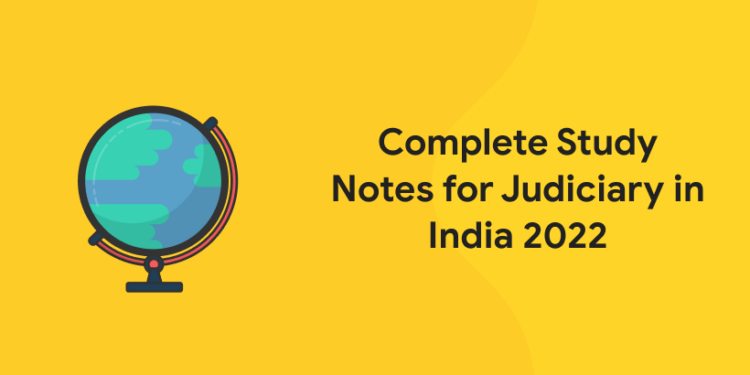Table of Contents
The Judiciary is the third organ of the government which makes sure that the other two organs stay within the boundaries laid by the constitution. Judiciary in India resolve the dispute between a citizen and the state, between citizen and citizen or between two states. From the common man’s perspective, Judiciaryis the most important organ of the government because it protects a citizen from the flawed functioning oflegislative and executive organs. The role of the Judiciary as the protectorof the constitution and the fundamental rights of the individuals makes it more reputable than the othertwo organs.
Click here to know more details of SSC Exams
Structure of Judiciary in India
India’s judicial system is divided into three levels, each with a group of subsystems. The Supreme Court, often known as the Apex Court, is India’s highest and final court of appeal. Its highest authority is the Chief Justice of India. Chief Justices of States control and manage the state’s highest judicial bodies, the High Courts. District Courts, also known as subordinate courts, are below the High Courts and are governed and supervised by District & Sessions Judges. The civil court, which is headed by a Sub-Judge, is followed by the municipal court at the lower level; and the criminal court, which is headed by a Chief Judicial/Metropolitan Magistrate at the top and followed by the municipal court at the lower level.; and the criminal court headed by Chief Judicial/Metropolitan Magistrate at top and followed by ACJM /ACMM & JM/MM at the lower level.
Click here to read the latest general awareness blogs
The Supreme Court of India
1: Who was the first woman President of India?
- Also known as the guardian of the Indian constitution and protector of fundamental rights
- founded on 28th January 1950
- The federal court which was established in 1937 by the government of India act 1935 later becomes the supreme court of India.
- Situated in Thilak Marg, New Delhi
- The formation of the supreme court is discussed in article 124
- The number of judges is decided by parliament
- Initially, there were 8 judges including the chief justice. Now it is raised to 34.
- Chief justice and judges are appointed by the President. Oath taking is also done in front of the President of India. A resignation letter is also submitted to the president.
- Supreme court issue writs by article 32
- The official language of the supreme court is English. (article 348)
- Supreme court Chief justice has a salary of Rs 280000. Judges have a salary of Rs 250000. Both are given from the consolidated fund of India.
- Supreme court is the court of record- article 129.
- Advisory jurisdiction of a court- article 143
- To become supreme court judge
- Should be a citizen of India
- 5 years experience as high court judge/ 10 years as an advocate in the high court
- Should be an eminent law scholar in the eyes of the president.
- The first chief justice of India- Harilal. J.Kaniya
- Supreme court judge with the longest term- Y V Chandrchood
- Supreme court chief justice with the shortest term- Kamal Narayan Singh
- First women judge of Supreme court- M. Fathima Beevi
Click here to know about other government exams
Free UPSKILLING Courses!
Take your first step toward mastering in-demand skills, acing interviews, and securing top-tier jobs with Entri's free upskilling courses.
Start Learning!High courts of India
- Articles related to the high court- 214 to 231
- Article mentioning the need for a high court in each state- 214
- Oath taking of high court chief justice is done under the power of the governor
- Power of high court to issue writs- article 226
- High court chief justice and judges are appointed by the president.
- Number of high courts in India- 25
- The salary of high court chief justice is Rs 250000 and that of judges is Rs 225000.
- To be eligible for the position of a high court judge one should have the following qualities
- Should be an Indian citizen
- Should have experience as a judicial officer for 10 years or as an advocate in the high court for 10 years.
| Name of court | Founding year | Headquarters | States under jurisdiction |
| Bombay | 1862 | Mumbai | Maharashtra, Goa, Dadra and Nagerhaveli and Daman and Diu |
| Kolkata | 1862 | Calcutta | West Bengal, Andaman and Nicobar |
| Chennai | 1862 | Chennai | Tamilnadu, Puducherry |
| Allahabad | 1866 | Allahabad | Uttar Pradesh |
| Karnataka | 1884 | Bengaluru | Karnataka |
| Patna | 1916 | Patna | Bihar |
| Madhya Pradesh | 1936 | Jabalpur | Madhya Pradesh |
| Jammu and Kashmir | 1943 | Jammu & Srinagar | Jammu & Kashmir, Ladakh |
| Punjab, Haryana | 1947 | Chandigarh | Punjab, Haryana, Chandigarh |
| Guwahati | 1948 | Guwahati | Arunachal Pradesh, Assam, Nagaland, Mizoram |
| Odisha | 1948 | Khattak | Odisha |
| Rajasthan | 1948 | Jodhpur | Rajasthan |
| Hyderabad | 1954 | Hyderabad | Telangana |
| Kerala | 1956 | Kochi | Kerala, Lakshadweep |
| Gujarat | 1960 | Ahmedabad | Gujarat |
| Delhi | 1966 | New Delhi | Delhi |
| Himachal Pradesh | 1971 | Shimla | Himachal Pradesh |
| Sikkim | 1975 | Gangtok | Sikkim |
| Chhattisgarh | 2000 | Bilaspur | Chhattisgarh |
| Jharkhand | 2000 | Ranchi | Jharkhand |
| Uttarakhand | 2000 | Nainital | Uttarakhand |
| Meghalaya | 2013 | Shillong | Meghalaya |
| Manipur | 2013 | Imphal | Manipur |
| Tripura | 2013 | Agartala | Tripura |
| Amaravati | 2019 | Amaravati | Andhra Pradesh |
Study the table above to answer the questions regarding the high courts of India. Download the entri app to learn more with the instruction of experienced educators and updated notes.










